Living Well: An Environment Where Athletes and Employees Can Thrive
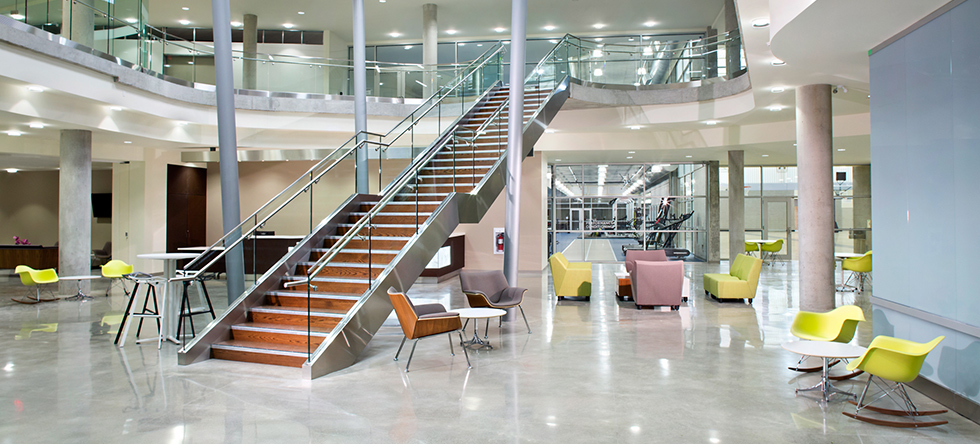
Key Points
What We Know
Physical inactivity is exacting a serious toll on the health and well-being of people around the world. Globally, over 30 percent of people aged 15 or older are not getting the exercise they need, due in part to a lack of physical activity during leisure time and an increase in sedentary behavior in domestic and occupational situations.*1
In Canada, such inactivity is a major factor in its rising rate of obesity, which has hit record levels: 25.3 percent in 2011, a 13 percent increase from 2003.*2 (The obesity rate in the United States is even higher: 35.7 percent, according to the Centers for Disease Control.*3) The rate among Canadian youths and children has nearly tripled in the last 30 years (currently 31.5 percent of five- to 17-year-olds*4) putting them at a higher risk of developing a variety of health problems, including diabetes, heart disease, and stroke, that will likely continue into adulthood.*5
Inactivity is also taking a toll on the Canadian healthcare system. "Physical inactivity has surpassed epidemic proportions in Canada and accounts for a significant portion of healthcare spending,” according to a 2012 Queen's University study. That study estimates that the direct and indirect healthcare costs of physical inactivity were nearly $6.8 billion in 2009, which is 3.7 percent of all Canadian healthcare costs.*6
Meanwhile, the benefits of active living, including athletic pursuits at all levels, are clear. Regular physical exercise, including team sports, improves fitness and helps control weight. It can lower stress levels, boost self-esteem, and elevate academic achievement.*7 There's also evidence that active people are more productive and less likely to miss work due to illness and injury.*8
The Canadian healthcare system, like those of many developed countries, is designed to care for people already afflicted with disease, illness, or injury. It's not designed to support and fund sports and athletic pursuits as part of any preventive, proactive medical program.
Therefore
Because determinants of healthful living, such as physical activity, lie outside the reach of the public healthcare system, Canadian communities are seeking ways to provide people with venues of activity, supervision, and care.
Such initiatives bring with them the opportunity to put aside the pathogenic model, where health is considered a condition without disease, in favor of a salutogenic model, which focuses on factors that support and promote health and well-being. This approach looks at “health” the way that the World Health Organization does: “Health is a state of complete physical, mental, and social well-being and not merely the absence of disease or infirmity.”*9
Design Problem
In Burnaby, British Columbia, with community and philanthropic support, a nonprofit organization envisioned integrating, under one roof, programs and services in sport medicine, sport training, and sport science.
By paying individual attention to all kinds of athletes—from elite high-performers to people taking their first steps toward more healthful living—this philanthropic, private-sector effort committed itself to welcoming and serving anyone committed to fitness and/or performance goals. In doing so, it would keep the athlete-client at the centre of everything. An important part of this approach would be the ability to create and maintain an electronic medical record and an individual care plan for each client that would be accessible to an interdisciplinary team of practitioners.
Beyond a physical plant that could support these goals, the organization envisioned a design that would foster and express a culture of collaboration, involvement, and ongoing improvement. It sought a solution that would attract and retain highly qualified practitioners willing to work within a nonhierarchical, participatory structure. It sought, in short, to do what hadn't been done before in Canada.
Design Solution
With the opening of the Fortius Athlete Development Centre in Burnaby, British Columbia, the results of this effort are there for all to see. Building upon the sport medical model that was developed for the Vancouver 2010 Olympic and Paralympic Winter Games, and engaging many of the same people who made that effort such a success, the centre is the first fully integrated sport medicine, science, and training venture in Canada.
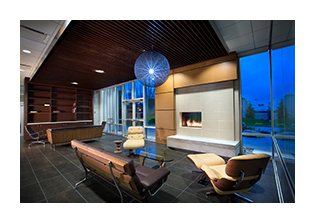
Comfortable areas for relaxation, conversation, and collaboration are available throughout the centre.
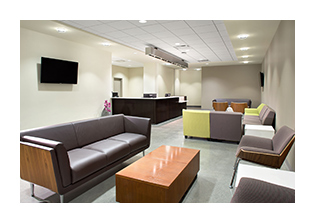
This waiting area and reception station is typical of those found throughout the centre.
At its core, Fortius Sport & Health is an integrated athlete-development centre. The Fortius Sport & Health organization includes the Fortius Foundation, a registered charity funding world-class sport medicine and science facilities, and the Fortius Institute, an integrated team of sport medicine, science, and training leaders committed to best practices in prevention, performance, treatment, education, and research. The Fortius Foundation Capital Campaign to raise $61 million for the 148,000-square-foot facility includes a $23 million donation by Scott Cousens, founder and chair of the project. To date, his is the largest individual donation to sport in Canadian history.
Robust funding propelled Fortius on its mission to become “an integrated development centre strengthened through philanthropy and focused on optimizing human performance for life.”*10 To that end, Fortius sought to create an environment where athletes of all kinds could thrive—a hub offering programs and services to help clients of all ages and levels of ability remain healthy and active throughout their lives.
“We started from scratch,” says Lynda Cannell, who served the project in an advisory capacity since its inception and is now chief operating officer of Fortius Sport & Health. “We had a vision of what we wanted the centre to be, but the real work was, and is, making that vision a reality.”*11
“The vision and the day-to-day operations must be in sync with each other. That's where the dance is,” says Lynn Furlotte, executive director of the Specialist Referral Clinic and a member of the Business Advisory Board at Fortius Sport & Health.*12 Using her experience as a specialist in the healthcare sector, she has helped Fortius develop a client-service model that further establishes its uniqueness in the healthcare domain.
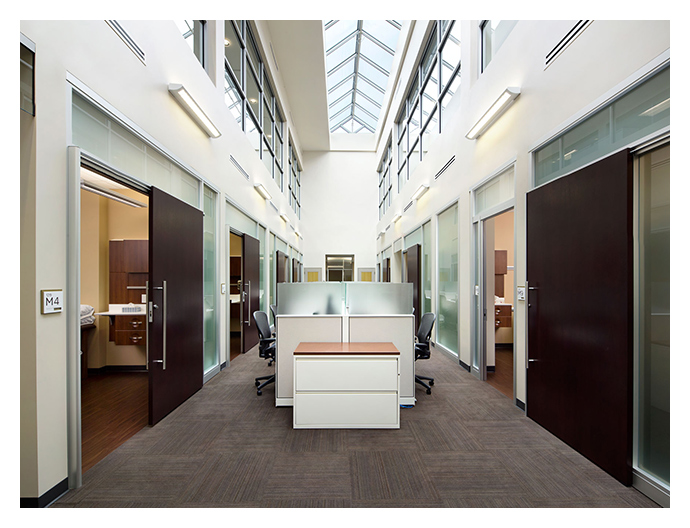
Along this corridor, multiple exam rooms serve clients' needs.
Anthony Abrahams, principal of Emblematica Brand Builders, has also served as a consultant on the project, bringing together many of the key partnerships that enabled it to move forward. “The core of the Fortius vision is the optimization of human performance,” he says. “We set out to create an environment that could help everyone live fitter, happier lives.”*13
He says that Fortius's partnership with Herman Miller has been key to making this happen. “We look for partners who can help us realize this vision,” says Abrahams. “Herman Miller brings an expertise that goes far beyond furniture. They understand how environments can put people in a position to succeed.”
The partnership grew out of a meeting that Fortius had with Herman Miller. “When we first met with Herman Miller about the project,” says Cannell, “our building had been started but it wasn't complete. We needed help understanding what it was possible to achieve within it. Through a variety of practical working sessions, they motivated us to really look at what we were doing and to rethink what we could do. They helped us appreciate the power of space—the impact that an environment can have.”
“Herman Miller pushed us to think about things in new and different ways,” says Furlotte. “They challenged us to look closely at our goals and the best ways to achieve them.” Following this initial consulting, Carla Maruyama, strategic account manager, Herman Miller Canada, arranged a trip to Herman Miller headquarters in Michigan to give Fortius a closer look at the company's people, places, and practices. Cannell calls that trip “a turning point for us.”
“We saw how an environment can help shape a culture,” she says, “the kind of human-centered culture that we are seeking and developing.” Herman Miller's customer experience program also had a big impact. “We experienced it firsthand,” she says, “and we knew that it was a model of the kind of personal approach we were looking for.”
“Herman Miller was the right company to help us create and cultivate a collaborative environment among the various disciplines and generations that work together here,” Furlotte adds. “Their knowledge and research were really valuable to us—and continue to be.”
The public and private spaces within the centre had to support the varied needs of client-athletes, teams and coaches, and the integrated team of sport medicine, science, and training leaders that compose the Fortius Institute. The centre needed to align with Fortius's vision. It needed to express its culture and embody its principles of integration, collaboration, and innovation. And it needed to be a place that would attract leading practitioners from around the world.
With this understanding of what Fortius wanted to achieve, and with Workplace Resource, a certified Herman Miller dealer in Vancouver, taking on the programming, design, and planning, the project moved ahead. It culminated in September 2013 when the bright, spirited, modern facility officially opened its doors, with a group of sought-after practitioners in place. They include performance and fitness specialists, physicians, physiotherapists, chiropractors, massage therapists, registered nurses, physiologists, nutritionists, and biomechanists. “They all want the opportunity to work within this new model of integration and collaboration,” says Cannell.
Included in that model is another key component of the client-centered approach: an all-in-one-place individual electronic medical record for each client—created, shared, and kept current by any or all of the practitioners.
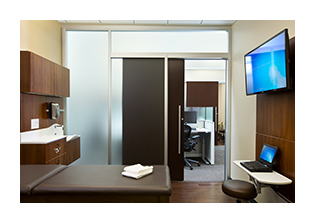
Examination rooms like this support technology and the need for privacy.
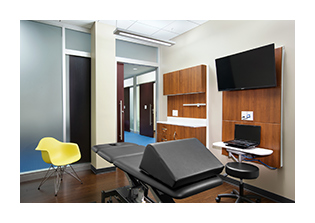
Examination and treatment rooms bring athletes and practitioners together in an uncluttered space.
The Fortius client-centered focus plays out in a facility that includes an array of places and spaces for clients, staff, practitioners, and the public.
Openness and adaptability are key elements of the design. The facility’s open areas encourage and facilitate collaboration, impromptu interactions, and information sharing. Its furniture solutions are able to adapt to the changing needs of clients and staff. “Instead of open spaces, we were initially considering sheetrock walls and opaque doors,” says Cannell. “But when we recognized the need for more flexibility, we saw how Herman Miller products such as Compass™ provide a reconfigurable, modular casework approach that makes much more sense and changes much more easily.”
Office and open workspaces give employees options to sit, stand, and move as they work alone or with others. Offering and encouraging such movement and postural change is healthful in itself. Prolonged sitting is a key contributing factor to the sedentary life that so many people lead. One 12-year study, which followed 17,000 Canadians, aged 18 to 90, showed that “daily time spent sitting was associated with an elevated risk of all-cause and cardiovascular disease mortality … independent of leisure time physical activity and body mass index.”*14 The human body is made to move, and the Fortius Athlete Development Centre is all about movement, even in its office spaces.
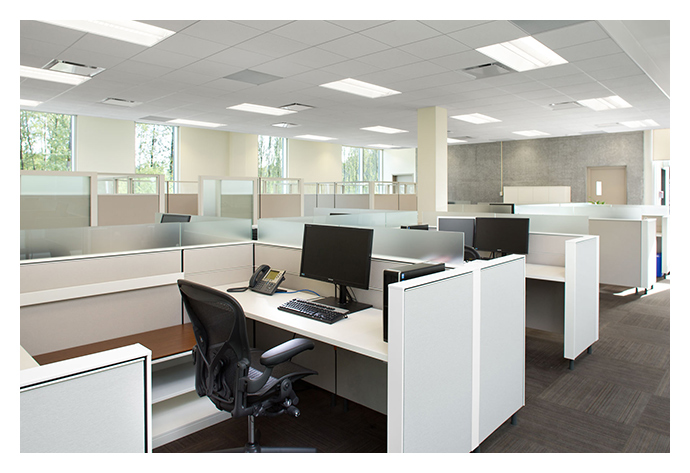
Staff members use these open, accessible workstations.
Research suggests that the quality of the built environment plays a highly important role in our health and well-being, says Julie Sless, vice president, Herman Miller Canada. “In promoting the importance of activity and sports for children, adults, and families, the centre provides a place that models a culture of health. It's an invigorating atmosphere that invites participation. In many ways, the centre reflects a salutogenic model, a human-centered design that promotes working, healing, and living well.”*15
That model has the advocacy of some well-known Canadian athletes who have taken an active role in using, supporting, and promoting the facility. One of those is Steve Nash, long-time NBA all-star, general manager of Canada Basketball's men's national team, and member of the Fortius Athlete Advisory Board. At the centre's opening ceremonies, with a group of Burnaby high school students on hand, and with local and national television cameras and media reporting, Nash stepped to the free-throw line in the gymnasium and, to loud cheers, sank the first shot in the centre's history.*16 “Athletes like Steve Nash serve as role models for everyone, especially youth,” says Abrahams.
Among those who have toured the centre are health ministers and other government officials. “They're especially interested in the focus on the client and the professional collaboration that's taking place,” says Cannell. “We have invested a lot of time understanding how work will be done today and in the future and recognizing the importance of the client experience. If we had jumped into design too quickly, the outcome may not have been as aligned with our vision as it is. While the level of service we're providing is unique, there are things that other clinics, both public and private, can learn from what we're doing here.”
1. “ Physical Inactivity: A Global Health Problem,” World Health Organization, http://www.who.int/dietphysicalactivity/factsheet_inactivity/en/ (accessed November 14, 2013).
2. Jason Koebler, “Canadian Obesity Rates Hit Record Levels,” US News and World Report, February 27, 2013, http://www.usnews.com/news/articles/2013/02/27/canadian-obesity-rates-hit-record-levels (accessed November 14, 2013).
3. “Adult Obesity Facts,” Centers for Disease Control and Prevention, August 16, 2013, http://www.cdc.gov/obesity/data/adult.html (accessed November 14, 2013).
4. “ 31% of Canadian Kids are Overweight or Obese,” CBC News, September 20, 2012, http://www.cbc.ca/news/health/31-of-canadian-kids-areoverweight-or-obese-1.1154456 (accessed November 14, 2013).
5. “ Health Care Costs of Physical Inactivity in Canadian Adults,” NRC Research Press, June 6, 2012, http://www.nrcresearchpress.com/doi/full/10.1139/h2012-061#.UptmoSg0_zI (accessed November 14, 2013).
6. “ Physical Inactivity a $6.8 Billion Burden to Canadians,” Queen's University News Center, June 6, 2012, http://www.queensu.ca/news/articles/physical-inactivity-68-billion-annual-burden-canadians (accessed November 12, 2013).
7. “ Benefits of Sports,” University of Missouri Health Care, http://www.muhealth.org/body_teens.cfm?id=4402 (accessed November 13, 2013).
8. “ Physical Activity,” Ontario Ministry of Health and Long-term Care, http://www.mhp.gov.on.ca/en/active-living/physical-activity.asp (accessed November 13, 2013).
9. “ WHO Definition of Health,” World Health Organization, http://www.who.int/about/definition/en/print.html (accessed November 13, 2013).
10. “A bout Us,” Fortius Sport & Health, (http://fortiussport.com/about-us)
11. Lynda Cannell, personal interview, October 30, 2013, for this and her subsequent quotes
12. Lynn Furlotte, personal interview, October 30, 2013, for this and her subsequent quotes
13. Anthony Abrahams, personal interview, October 30, 2013, for this and his subsequent quotes
14. “ Sitting Time and Mortality from All Causes, Cardiovascular Disease, and Cancer,” Pennington Biomedical Research Center and the Canadian Fitness and Lifestyle Research Institute, 2009, http://www.ergotron.com/portals/0/literature/other/english/ACSM_SittingTime.pdf (accessed November 13, 2013).
15. Julie Sless, personal interview, October 2, 2013
16. “ Canadian Basketball Star Steve Nash Makes the First Shot to Christen Fortius Athlete Development Centre,” Fortius Sport & Health, May 15, 2013, http://fortiussport.com/news/canadian-basketball-star-steve-nash-makes-firstshot-christen-fortius-athlete-development (accessed November 13, 2013).
Photo credit: Ema Peter
Company Informations:
Le Office Furniture Manufacturer
www.letbackrest.com
Address: No.12, Nanhua Road, LongJiang ,Shunde,Foshan, Guangdong, China (Mainland)
Email: sale@letbackrest.com
skype: kinmai2008

